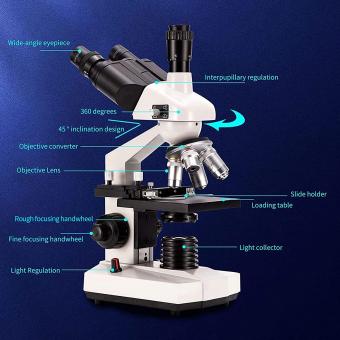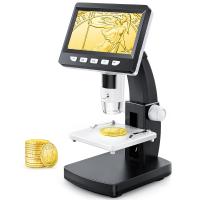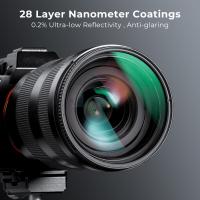Can Mitochondria Be Seen With A Light Microscope ?
Yes, mitochondria can be seen with a light microscope. However, they are very small and may not be visible without staining or other techniques to enhance contrast. Mitochondria are typically about 0.5 to 1 micrometer in diameter, which is at the limit of resolution for a light microscope. Therefore, they may appear as small dots or specks within a cell. To visualize mitochondria more clearly, researchers often use fluorescent dyes or antibodies that specifically bind to mitochondrial proteins. These techniques can help to highlight the shape, size, and distribution of mitochondria within a cell. Additionally, electron microscopy can provide even higher resolution images of mitochondria, allowing for more detailed analysis of their structure and function.
1、 Mitochondrial Structure
Yes, mitochondria can be seen with a light microscope. Mitochondria are small organelles found in most eukaryotic cells that are responsible for producing energy in the form of ATP. They are typically oval or rod-shaped and range in size from 0.5 to 1.0 micrometers in diameter and 2 to 7 micrometers in length.
Mitochondria can be visualized using a variety of staining techniques, such as the use of dyes that selectively bind to mitochondrial membranes or fluorescent probes that target mitochondrial proteins. These techniques allow researchers to observe the morphology and distribution of mitochondria within cells.
However, the resolution of light microscopy is limited by the diffraction of light, which means that structures smaller than approximately 200 nanometers cannot be resolved. This has led to the development of more advanced imaging techniques, such as electron microscopy and super-resolution microscopy, which can provide higher resolution images of mitochondrial structure and function.
Recent studies have also revealed that mitochondria are highly dynamic organelles that undergo constant fusion and fission events, which are essential for maintaining mitochondrial function and cellular homeostasis. These processes can be visualized using live-cell imaging techniques, which allow researchers to observe the behavior of mitochondria in real-time.
In summary, while light microscopy can provide valuable insights into mitochondrial structure and distribution, more advanced imaging techniques are required to fully understand the dynamic nature of these organelles.

2、 Mitochondrial Function
Yes, mitochondria can be seen with a light microscope. Mitochondria are small organelles found in most eukaryotic cells that are responsible for producing energy in the form of ATP through cellular respiration. They are typically oval-shaped and range in size from 0.5 to 1 micrometer in diameter.
Mitochondria can be visualized using a variety of staining techniques, such as the use of dyes that specifically bind to mitochondrial membranes or proteins. Additionally, fluorescent probes can be used to label mitochondria and allow for their visualization under a light microscope.
However, it is important to note that the resolution of a light microscope is limited, and therefore, the details of mitochondrial structure and function may not be fully visible. For example, the inner membrane of mitochondria, which contains the electron transport chain responsible for ATP production, is highly folded and can only be seen with higher resolution techniques such as electron microscopy.
In recent years, advances in super-resolution microscopy have allowed for the visualization of mitochondrial dynamics and interactions with other cellular components at a higher resolution than previously possible with traditional light microscopy. These techniques have provided new insights into the complex functions of mitochondria in cellular metabolism, signaling, and disease.

3、 Mitochondrial DNA
Can mitochondria be seen with a light microscope? Yes, mitochondria can be seen with a light microscope. However, they are very small and difficult to distinguish from other organelles in the cell. Mitochondria are typically about 1-10 micrometers in length and 0.5-1 micrometer in diameter, which is smaller than the resolution limit of a light microscope. Therefore, special staining techniques are often used to make them more visible.
Mitochondrial DNA, on the other hand, cannot be seen with a light microscope. Mitochondrial DNA is located within the mitochondria and is much smaller than the DNA found in the nucleus of the cell. It is estimated that there are hundreds to thousands of copies of mitochondrial DNA in each mitochondrion. While it cannot be seen with a light microscope, it can be visualized using electron microscopy or through various molecular biology techniques such as PCR and DNA sequencing.
Recent advances in microscopy techniques, such as super-resolution microscopy, have allowed for better visualization of mitochondria and other organelles at the nanoscale level. These techniques have provided new insights into the structure and function of mitochondria and their role in cellular processes. Overall, while mitochondria and mitochondrial DNA can be difficult to visualize with a light microscope, advances in microscopy and molecular biology techniques have allowed for better understanding of these important cellular components.

4、 Mitochondrial Biogenesis
Yes, mitochondria can be seen with a light microscope. Mitochondria are small organelles found in most eukaryotic cells that are responsible for producing energy in the form of ATP through cellular respiration. They are typically 1-10 micrometers in length and can be visualized using a light microscope with appropriate staining techniques.
Mitochondrial biogenesis is the process by which new mitochondria are formed within a cell. This process is essential for maintaining cellular energy homeostasis and is regulated by a complex network of signaling pathways. Recent research has shed light on the molecular mechanisms underlying mitochondrial biogenesis, including the role of transcription factors such as PGC-1α and NRF1.
Advancements in microscopy techniques have allowed for more detailed visualization of mitochondria and their dynamics within cells. For example, live-cell imaging using fluorescent probes can reveal the movement and distribution of mitochondria in real-time. Additionally, electron microscopy can provide high-resolution images of mitochondrial ultrastructure.
Overall, while mitochondria can be seen with a light microscope, the latest research has revealed a more nuanced understanding of their biogenesis and function within cells. Ongoing research in this field will continue to deepen our understanding of the role of mitochondria in cellular physiology and disease.








































